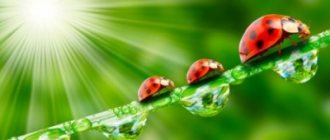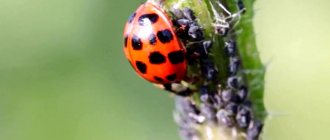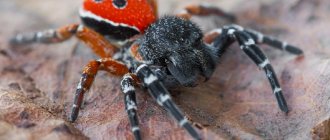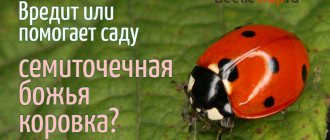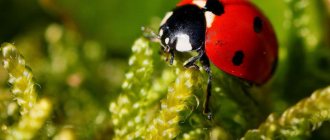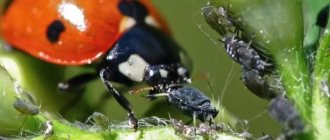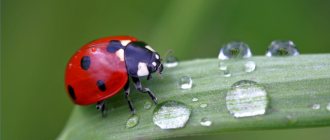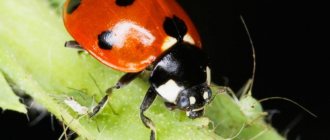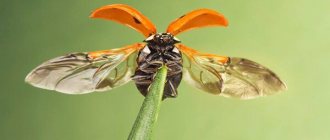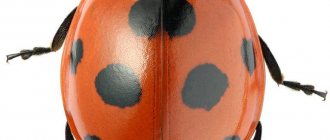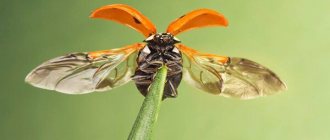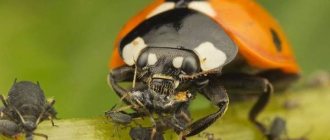Moscow is one of the greenest cities in the world. Parks, squares and natural areas occupy almost half of the capital's area. The number of trees and shrubs increases every year. Flowers add bright colors to the unique image of the city.
The condition of green spaces is monitored by specialists from the municipal services complex, among whom there are even entomologists. They identify pockets of pests that disrupt decorative plants, and beneficial insects that help preserve the diversity of urban flora.
Which of them benefit green spaces, and should people be afraid of them, said Elena Semenova, an entomologist at the Highways State Budgetary Institution.
Ladybug: Aphid Killer
Ladybugs are the most beneficial insects. They are valued not only in Moscow, but throughout the world. These seemingly harmless bugs are considered the main destroyers of harmful aphids.
“The ladybug cannot be confused with any other insect: the black dots on the red back immediately catch the eye. At the same time, few people know that there are quite a lot of their varieties. They come in white, black, yellow, and also with a different number of points: from two to 14. In total, there are about eight thousand species of ladybugs. In Moscow, the most common bugs are those with seven dots on a bright red shell,” says Elena Semenova.
Almost all representatives of this group of insects are predators. They eat not only aphids, but also scale insects, sawflies, psyllids and mites.
“There are different pests: leaf-biting, sucking, stem-boring. They are carriers of diseases that cause tree death. The main task of entomologists is to prevent this. Ladybugs and other predators help us with this, naturally reducing the number of harmful insects,” says Elena.
The larvae of ladybirds are particularly voracious. One individual eats from 70 to 300 aphids per day, helping to rid all types of urban plantings from them: from shrubs in courtyards to forested areas.
Adult beetles have quite powerful jaws. They can even bite a person, but this is not at all dangerous. There will be no damage to the skin, only a slight tingling sensation will be felt.
Lacewing: graceful predator
These are very elegant insects from the family Reticulate, one to two centimeters in size. The lacewing is easily recognized by its transparent wings. She got her name for her shiny golden eyes. The most common lacewings are pale green in color. Outwardly, they look a little like butterflies.
“Lacewings bring great benefits to trees and shrubs in public gardens and parks, protecting them from aphids, psyllids and caterpillars that curl and eat leaves. Moreover, only larvae hunt pests, while adult insects feed on pollen and nectar of plants. But even in the short time of its existence, the larva manages to bring invaluable benefits to the city, exterminating up to a thousand aphids per day,” says the entomologist.
At night, adult lacewings are guided by light, so they can often be seen on windows. Sometimes they fly into apartments and freeze on walls or lamps.
There is no need to be afraid of them: lacewings are completely harmless to humans. They may bite, but will not attack unless necessary. Moreover, this will only cause a slight unpleasant sensation, incomparable to a mosquito or wasp bite.
What insects can be found in the bathroom and toilet
In addition to mosquitoes, spiders and cockroaches, other unpleasant insects can live in the bathroom and toilet rooms. Among them, the most common types are the following:
- woodlice,
- silverfish (silverfish),
- millipedes (nodders and flycatchers),
- butterflies.
Let's take a closer look at what these insects are.
Woodlice
These unpleasant creatures are mistakenly classified as insects. Woodlice are actually animals that are classified as squamate crustaceans.
It is easy to recognize them: their distinctive feature will be a convex oval body without a clear division into the chest and torso. Woodlice have excellent protection from mechanical stress - their durable bony shell is segmented, due to which it can withstand heavy loads, protecting the animal from damage to internal organs.
In England, woodlice are called wood fleas because they are often found in damp woods and wooden buildings.
Woodlice feed on microscopic fungus, which forms a coating on the tiles, as well as particles of organic dirt and soap residues on the walls. They feel best in complete darkness, and if a bright light suddenly turns on, they can curl up their body into a ball and hide in cracks, crevices or under large objects.
Silverfish (silverfish)
Such insects from the order Bristletails are very common in damp and dark rooms. They can reach 2 cm in length, and move extremely quickly thanks to three pairs of short legs, at the end of which there are microscopic hooks. In addition, the amazing insect has color facet vision. They are most active at night.
Biologists are seriously of the opinion that the common silverfish (or sugarfish) is one of the most ancient insects that have inhabited our planet since the onset of the Paleozoic era.
The diet of silverfish is extremely varied. They eat not only available sugar, flour, pasta, cereals, and animal feed, but are also able to absorb paper, cardboard, glue and starch-containing fabrics. If it is possible to feed without long breaks, the insect can live up to five years.
Some time ago I noticed silvery whiskered pests in the bathroom. They turned out to be incredibly mobile, and many empty shells were found under the bathtub. The discovery that quite large insects live in the house unpleasantly surprised me. We had to take a set of measures to destroy them. The most effective was the chlorine solution, which I treated all surfaces with for a month. We also had to invite a plumber to fix all the leaks in the sewer pipes to reduce the humidity level in the room. The measures helped, and now silverfish have not been seen for a long time.
Kivsyaki
Those individuals that live in the bathroom and toilet rooms are small in size from 1 to 2.5 cm. Outwardly they look like a thin and long worm, but in fact they have excellent protection from mechanical damage - the strongest chitinous shell.
Invertebrates feed on plant organic matter, and upon close contact they curl up into a ball and become numb.
flycatcher
The flycatcher, like the nodule, is an arthropod, not an insect. A frightening-looking centipede often panics those who intend to calmly take a shower or visit the toilet.
This creature from the order of labiopods can reach a length of up to 6 cm, being the largest inhabitant of bathrooms. Its size directly depends on living conditions - with an abundant diet and a favorable atmosphere, the flycatcher becomes larger. With each molting phase of development, it acquires additional pairs of legs. An adult centipede has fifteen pairs.
The dense outer shell protects its internal organs from damage, providing invulnerability to mechanical stress. In addition, this type of centipede is distinguished by its incredible speed of movement; they are able to overcome up to 40–50 cm per second.
The eyes of flycatchers are located on the sides of the head, which provides good visibility and gives an advantage in hunting and protection from enemies.
The arthropod feeds on small insects, which it hunts, showing great aggressiveness. When it overtakes an insect or arthropod, it injects a potent toxic substance inside and then eats it.
The antennae, which help the flycatcher smell and touch prey, look like another pair of legs and are located at the end of the body. The flycatcher is active both in the light and in the dark; it is not afraid of light, but prefers not to show itself once again. The life cycle of a centipede can last up to seven years.
Butterfly
These insects, similar to miniature furry butterflies, look the least intimidating compared to other uninvited visitors living in the bathroom and toilet. The size of long-whiskered butterflies varies from 1 to 4 mm, so they can only be seen in detail using macro photography or a powerful magnifying glass.
Butterflies are also called sewer flies, since they feed on rotten organic matter both in the larval stage and in the adult state.
Most often, the insect has a silver color with a metallic tint and powerful wings covered with thick down and scales to protect against external damage. Under favorable conditions, butterflies reproduce in huge numbers - one individual can lay up to 100 eggs, from which voracious larvae appear within two or three days.
In twenty days, the larva goes through all the necessary metamorphoses, allowing it to become a sexually mature adult, ready for reproduction. Subsequently, the number of insects grows exponentially. Butterflies prefer to settle in entire colonies, which makes it very difficult to remove them.
It is usually especially difficult for residents of the first floors of apartment buildings. The favorite place of residence of butterflies is warm and humid basements, from which they penetrate higher through pipes.
Hoverfly: almost like a wasp
The hoverfly is one of the most amazing insects found in Moscow. Due to its black and yellow color, it can easily be confused with a wasp, but if you look closely, you can see a lot of differences.
According to the entomologist, the hoverfly has only two wings, unlike the four-winged wasp, and does not have a poisonous sting. But hoverflies differ especially strongly from wasps in their behavior - these insects often hover in the air, defending their territory. At the same time, they produce a characteristic murmuring sound, due to which they got their name.
The hoverfly is also called the flower fly or the bee's helper because it helps pollinate plants by collecting nectar and pollen with its proboscis.
Not only adult flies benefit, but also their larvae. They live in the crowns of trees, feeding on insects harmful to plants.
Effective methods for getting rid of insects living in the bathroom and toilet
The easiest way to get rid of all uninvited guests at once is to invite a special team of exterminators to treat the premises. However, this method is not suitable for everyone. If there is a small child or an allergy sufferer living at home, then treating common areas with aggressive professional compounds can lead to an unpredictable reaction from the body. It is important that such a service entails additional costs.
There are certain methods and means that can be successfully used independently to rid your home of insects and arthropods. These include the following:
- be sure to ventilate the bathroom and toilet, leaving the doors completely open for at least 3-4 hours daily. This will significantly reduce the level of humidity in small rooms and make the living conditions of pests less favorable,
- thoroughly treat all hard-to-reach places where insects love to settle with a household chlorine solution (90 g of powder per 3 liters of water). Such thorough cleaning should be carried out at least once a month,
- take special care to get rid of old plaque on the surface of tiles, walls and sinks, as it attracts woodlice,
- freezing of premises where unpleasant visitors were noticed. To do this, you need to open the windows in winter to significantly reduce the temperature in the bathroom and toilet. Many insects and arthropods cannot tolerate low temperatures and especially temperature changes,
- Do not allow accumulations of garbage, bulky rubbish and mold in the premises. Such a situation can provoke extremely rapid proliferation of pests,
- good results in getting rid of insects are shown by treating the bathroom and toilet with a solution of copper sulfate (100 g of sulfate per 10 liters of water),
- The wettest areas can be dried using a fan heater. The disadvantage of this method is that such processing will have to be carried out regularly,
- eliminate even the slightest pipe leaks so as not to create high humidity in the room,
- Use insecticidal sprays and fumigators sold in hardware stores with great care. Before purchasing, carefully read the instructions and do not carry out processing in the presence of children, pets or people with allergies.
To effectively eliminate insects in the bathroom and toilet, it is necessary to correctly determine the species of pests, and then take timely measures to eliminate them.
Ktyr: robber fly
Another fly that benefits the city is ktyr. This predator has a rigid proboscis and poisonous glands, which allow it to quickly neutralize its prey.
“This is one of the most aggressive insects. Because of his lightning-fast reaction and gluttony, he was nicknamed the robber fly. Ktyr hunts almost all pests and is capable of biting through even very hard shells. It behaves very aggressively even towards such well-armed insects as wasps, bees or hornets,” says Elena Semenova.
Ktyr larvae are no less dangerous hunters. They are the ones who bring the greatest benefit to humans. The larvae live in the soil, feeding on pests that damage plant roots. These include wireworms, click beetles and caterpillars.
For a person, the bite of a bird is similar to a bee sting. It can be very painful and cause itching, burning and swelling. Therefore, it is advisable to avoid these insects, but under no circumstances should you kill them - they are very valuable and are even listed in the Red Book.
Inspection of green spaces
Entomologists of the State Budgetary Institution "Highways" conduct surveys of green areas from April to September, during the growing season of plants. Over the past summer season, they examined about 200 objects. These are areas along highways, highways, at MKAD interchanges, as well as public gardens and some large parks.
“If, as a result of monitoring, pest outbreaks are detected, we inform the specialists who care for the plants about the need to treat them with special preparations. In this case, safe biological agents are used that affect certain types of insects without endangering beneficial predators. If the number of pests is insignificant, then a mechanical method of control is used,” notes Elena Semenova.
According to the entomologist, due to the favorable environmental situation in Moscow there are quite a lot of beneficial insects. In addition, the city holds special events to increase their population. For example, in the winter the soil of flower beds is covered with wood chips, which allows insects to more comfortably survive the cold period.
And in some natural parks, special houses are installed for wintering insects. Outwardly, they resemble birdhouses, but without the front wall. The interior space of the houses is filled with dry hollow stems of nettle, horse sorrel, Sakhalin buckwheat, and tree branches and pine cones are placed. Osmium bees, pollinating plants of the entomophilous group, beneficial beetles and ladybugs usually live in such “hotels”.
Causes of insects
The main reason for the appearance of unpleasant visitors in the bathroom and toilet is high humidity and stable heat. This atmosphere is loved by woodlice, silverfish, and centipedes. Butterflies are attracted by the rotting of organic matter in the sewer and the opportunity to breed numerous offspring there.
Insects and arthropods enter the bathroom and toilet through ventilation holes in the walls, from basements through cracks and through sewer pipes. Having entered the home, unpleasant guests begin to multiply vigorously and soon populate all suitable places.
The last floor is just as dangerous in terms of pest infestation as the first floor. The fact is that attic spaces are heated by the sun in summer, and during rains moisture gets inside through holes in the roof. This creates favorable conditions for the life and reproduction of insects.
Habitats
The most common habitats for insects and arthropods in the bathroom and toilet are:
- pipes on which condensate accumulates,
- secluded and unlit corners (behind the washing machine, under the bathtub, behind the toilet, etc.),
- wet rags,
- puddles under the bathtub near the leak area,
- in cabinets filled with boxes and bottles of cleaning products.
